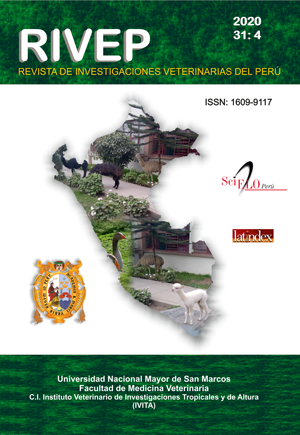Apparent digestibility of a diet including sacha inchi (Plukenetia volubilis L) seed meal in growing creole pigs
DOI:
https://doi.org/10.15381/rivep.v31i4.19245Keywords:
creole pigs, growth, digestibility coefficients, Sacha inchiAbstract
The aim of this study was to determine the apparent faecal digestibility of a diet including sacha inchi (Plukenetia volubilis L) seed meal in growing creole pigs. Two male castrated pigs were used, body weight of 50 ± 2 kg, housed in metabolic cages, and under a 2x2 Latin square design. The pigs were fed diets with 0 (control) and 15% inclusion of sacha inchi seed meal, respectively. In the experimental diets and in the faeces it was determined: dry matter (DM), crude protein (CP), crude fibre (CF), fat, nitrogen-free extracts (NFE), gross energy (EB), calcium (CA) and phosphorus (P). The highest apparent digestibility coefficients of DM (82.38%) and P (32.32%) were obtained in the control diet (p<0.05). There were no significant differences for the digestibility of CP, CF, fat, NFE and Ca. In conclusion, the inclusion of 15% sacha inchi seed meal in the diet of growing creole pigs does not affect the apparent digestibility of CP, CF, fat, NFE and Ca, allowing a feed with high nutritional value.
Downloads
Downloads
Published
Issue
Section
License
Copyright (c) 2020 María Isabel Viamonte, Marisol Tipanquiza, Carolina Tintín, Janeth Sánchez, Willan Caicedo, Alina Ramírez, Julio Vargas

This work is licensed under a Creative Commons Attribution-NonCommercial-ShareAlike 4.0 International License.
AUTHORS RETAIN THEIR RIGHTS:
a. Authors retain their trade mark rights and patent, and also on any process or procedure described in the article.
b. Authors retain their right to share, copy, distribute, perform and publicly communicate their article (eg, to place their article in an institutional repository or publish it in a book), with an acknowledgment of its initial publication in the Revista de Investigaciones Veterinarias del Perú (RIVEP).
c. Authors retain theirs right to make a subsequent publication of their work, to use the article or any part thereof (eg a compilation of his papers, lecture notes, thesis, or a book), always indicating the source of publication (the originator of the work, journal, volume, number and date).



